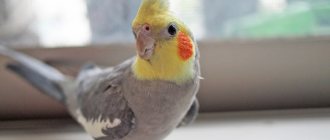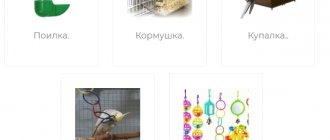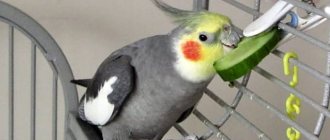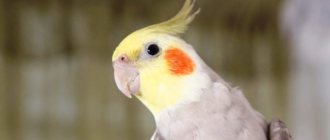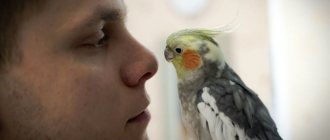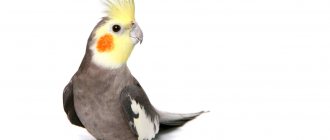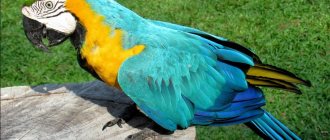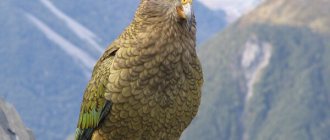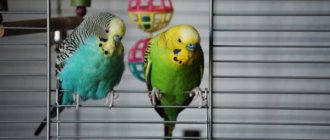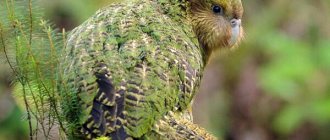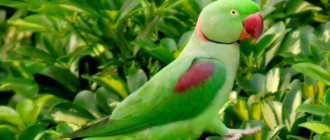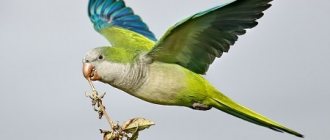09 November55109decorative birdscorellacockatooparrot
The cockatiel is a talking parrot from the cockatoo family, also called a nymph. This charming bird is native to Australia. The Corella parrot will be an excellent pet that will delight you not only with its exotic appearance, but also with its singing abilities. In this article you will learn how to tame a cockatiel and teach it to speak, and also find useful information about keeping a cockatiel.
History of discovery
Cockatiels are native to Australia. In 1838-1840 the famous ornithologist and animalist John Gould visited this country with a zoological expedition and took from there about 800 birds, among which was the Nymph. The scientist wrote and published the book “Birds of Australia”, where he gave a complete description of their appearance and way of life.
In the forties, cockatiels spread throughout Europe. The fact that they are now present in our lives is the merit of the breeders. In the sixties of the last century, the Australian leadership banned the export of parrots outside the state. After this, selection and breeding of Corellas proceeded without the participation of wild winged birds.
Where does the cockatiel live?
Photo: Corella in Australia
In nature, they live only on one continent - Australia, whose climate is ideal for them, and there are relatively few predators for which these small parrots serve as prey. Flying away domestic cockatiels on other continents are not adapted to life in nature and die.
First of all, this applies to those pets that were kept in the temperate zone - they are very demanding of the climate and are not able to survive even the autumn or spring cold, not to mention winter. But even if they fly free in a warm climate, they are quickly caught by birds of prey.
In Australia, they are practically never found near the coast: they prefer to live inland in an arid climate. However, it is not so rare to settle near the shores of lakes or rivers. But most often they live in grassy steppes, on large bushes, trees, and rocks overgrown with vegetation. Found in semi-deserts.
They love space and open areas, so they do not go deep into forests, but they can also settle on the edges of eucalyptus groves. If the year turns out to be dry, they gather near remaining bodies of water. Many cockatiels live in captivity, where they actively breed. They like to keep these parrots in North America, Europe, and Russia; they can also be found in Asian countries. There are such a large number of them in captivity that it is difficult to say where there are more of them - in nature or in humans.
Corella Parrot Information
Birds of the cockatoo family have a number of interesting differences from their own kind. Their characteristics will help many decide whether it is worth purchasing such a miracle for keeping at home.
What you need to know to properly care for such wards.
Information about the cockatiel parrot
Characteristic
The popularity of the Corella parrot is approximately on the same level as its large brothers: macaws, grays and cockatoos. While the leading position is still held by the budgerigar. Unlike the latter, the cockatiel is more prone to learning: it imitates sounds relatively easily, including human speech.
These are friendly and curious birds. If the bird is kept alone, then close contact with a person can be achieved already in the first hours of communication. As for care and maintenance, the pet does not require any specific food or conditions.
The female, by virtue of her instincts (preparing for nesting), almost every day puts “order” in the house, throwing everything unnecessary, in her opinion, outside the cage. In this regard, males behave more selfishly, caring mostly for themselves rather than for housing, which should be taken into account when choosing a bird.
In the photo there is a cockatiel nymph parrot:
Natural shades of feathers
Natural plumage colors are required for Corellas to camouflage in their natural environment. Therefore, birds living in freedom are carriers of a simple color. In most cases, gray predominates with a yellow crest on the head and orange dots on the cheeks. Some have subtle yellow or white feather tips on their heads.
The wings are brown. The bellies are light gray in color. There are red-cheeked (with red cheeks) and rosy-cheeked (with pink cheeks) Corellas. Albinos are often found in nature.
Natural feather color of a parrot
How to tell if a parrot is sick
Corella Nymphs are very sociable birds, gentle, obedient, intelligent, moderately active. They love affection, scratching, stroking, and are cheerful. You need to play and communicate with them. Therefore, if you suddenly notice that your pet has become too quiet and sad, this should alert you.
It also happens, on the contrary, that the cockatiel becomes too active: she rushes around the cage, screams loudly and a lot, pulls out feathers, itches all the time, becomes nervous and aggressive. A sick parrot always differs in behavior from a healthy one.
You will need to observe the bird and conduct an inspection.
- A bird that has been struck by some kind of disease will be lethargic, apathetic, and indifferent to what is happening. Sick parrots sit on a perch, closing their eyes, ruffling their faces, and refuse to eat.
- Examine the feathers. In a healthy bird they are smooth, shiny, and fit neatly together. If the plumage is damaged or broken, you need to sound the alarm.
- Feathers stuck together on the breast may be due to vomiting due to an infectious disease of the goiter, and contaminated feathers near the cloaca may be due to digestive disorders.
- A healthy cockatiel's beak is shiny, without any irregularities, growths, peelings or formations.
- If the parrot's eyes are dull and discharge appears, this is a signal of internal trouble.
- By carefully moving back the feathers in the area of the ear canals, you will find the parrot's ears. Inspect them for foreign bodies and inflammation.
- The cockatiel's illness is indicated by intermittent, frequent, heavy breathing.
- If, when palpating the muscles on your pet’s chest, you can easily feel the chest bone, especially if it is noticeable without palpation, this may indicate malnutrition or muscle atrophy.
Differences between male and female
Representatives of different sexes differ from each other in minor nuances of physique and coloring. Boys are more remarkable and beautiful than girls. Their feathers are painted a rich olive color. The head and crest are bright sunny. There are many reddish round markings on the cheeks. The wings are marked with white mirrors. Tail and flight feathers have a bluish sheen.
Females look much simpler in appearance. The lower half of their body is red. The yellowish color of the crest contains a small amount of gray shades. The head is yellowish-dirty, and there are brick-brown patches on the cheeks. There are yellow dots on the inside of the flight feathers. The tail is marked with black transverse stripes. It is much wider in females.
How old do cockatiels grow?
Cockatiel chicks are born weighing only a few grams, but they literally grow by the clock. Intensive growth occurs in the first month of life. Then the bird starts to have a lot of fluff and feathers, and it seems to grow. However, this is an illusion created by increasing the volume. By the year the bird gains an average of 80 g, and the length of its body, including the tail, is 30 cm. Puberty occurs at the age of nine months in men and somewhat later in women.
It is difficult for an inexperienced owner to determine what age a parrot has reached. For breeders for whom keeping parrots is part of their life, the task is much easier. But even professionals find it difficult to say how old an adult cockatoo is, accurate to the nearest year.
Intelligence and character of a parrot
Breeders love Corella very much for her affectionate, simple and good-natured character. Their mental abilities are well developed. They are easy to train and tame. Birds are able to learn up to several dozen words from the human vocabulary.
Character and intelligence of a parrot
This species of parrot does not have a good voice, so it is pointless to expect intelligible and clear pronunciation from them. Representatives of the species are able to parody animals and copy the sound of working technical devices. When a bird is in a state of extreme pleasure, it begins to sing, whistle, and pronounce words.
It should be noted that Corellas are overly talkative, which often causes hostility among the people around them. In a state of anger or fear, they make ear-piercing, unpleasant sounds.
The character of the Nymphs is fickle. Adding another individual to the cage, awakening sexual desire, or simply feeling unwell can dramatically change their behavior. The owner should refrain from the desire to scream, scare, or push the pet away from him. Trust can only be earned through affection and kindness.
Cockatiels are difficult to train, especially when their character has already been formed. Adult birds have a hard time accepting new owners and unusual housing. You can raise an intelligent and obedient pet only from a small chick. To do this, you need to work with him every day from the moment his adaptation period ends.
Raising a cockatiel
Keeping at home
Arrangement of housing for your pet should be done before purchasing it. First of all, it is worth paying attention to two key points - the cage and nutrition. In pet stores you can find specialized options for both the first and second, which significantly eases the difficulty of choosing.
Which cell to choose
The cage should be selected taking into account the size of the bird. If the pet lives alone, then the minimum housing size is 50 x 40 x 60 cm.
But ornithologists recommend larger solutions - 100 x 40 x 60 cm. If you are planning a pair of parrots, then the size of the cage should be increased by one and a half times.
It is better to avoid purchasing solutions in the “skyscraper” format. Cockatiels prefer to move in a horizontal plane, rather than, like canaries, in a vertical plane.
As for the material, it is more advisable to choose stainless or chrome rods without wooden inserts. Corellas love to chew on anything and everything, so any pliable material, such as wood or soft synthetics, will not only be destroyed, but also eaten. And this will negatively affect the health of the pet.
The presence of a pallet will minimize the hassle of cleaning. Moreover, not every bird will like a frequently flickering panicle invading its personal space. More advanced solutions are equipped with two pallets, which adds convenience. While the owner calmly cleans one part, the second protects the cage frame from contamination.
Place for a cage
The best option is against a wall no lower than 1.5 meters from the floor. This way the bird will feel protected. It is good if the room is well lit, but direct sunlight should not fall on the cage. It is not advisable to carry it, because the pet will experience stress.
The cage should not be placed near heating devices or in a draft . Temperature changes will immediately have a negative impact on the health of the animal. Therefore, the kitchen is not the best option.
Cockatiels quickly get used to the realities of a city apartment: the noise of TV, radio, telephones, etc. However, loud and sudden sounds can greatly frighten the bird. The support where the cage stands must be reliable: a swaying frame will irritate the bird.
At night, your pet needs rest. If for some reason this is not possible, then the cage should be covered with a blanket. Afterwards, when the parrot calms down, you can remove it or open one of the sides.
Accessories
The cage should at least partially imitate the animal's natural habitat. This can be done using a variety of accessories, since there are more than enough of them in specialized stores.
The minimum set includes:
- perches/perches;
- feeder;
- drinking bowl;
- swimsuit
Perches play an important role in the development of birds. Properly selected crossbars not only allow your pet to rest from playing, but also form a grip, which is especially important for young animals. When choosing perches, you should take into account the subspecies of the animal, as well as its dimensions. If the perch is smaller in diameter, the bird will experience noticeable discomfort, and the legs will develop pathologies.
Ornithologists recommend looking towards wooden solutions with irregular shapes. These perches do not emit toxic fumes like plastic and are inexpensive. Concrete bars can be used to sharpen the beak, but they are not suitable for perching because they do not retain heat well. It is more advisable to buy both the first and the second, and the bird itself will figure out which is more convenient for it.
You can make the poles yourself. It is enough to collect branches in the forest belt and use a knife to give them the desired shape. The best option for a parrot is birch, willow or fruit trees.
Nutrition
A balanced diet is the key to good health and longevity of birds. The optimal solution for cockatiels is ready-made grain mixtures that include herbal ingredients. You can buy them at any pet store.
In addition to basic dry food, birds require fruits and vegetables to compensate for the lack of vitamins and minerals. It would also be a good idea to install a mineral stone or sepia stone in the cage. They will not only provide your pet with the necessary elements, but will also help sharpen the beak.
It is more advisable to buy food in trusted stores rather than at the poultry market. In a good half of cases, grain purchased from hand is only partially processed or not sifted at all. Such food can cause both poisoning of the animal and infection with parasites: fleas, ticks and lice eaters.
Fruits, berries and vegetables necessary for cockatiels:
- apple;
- banana;
- watermelon;
- peach;
- raspberries;
- cranberry;
- grape;
- carrot;
- tomato;
- zucchini;
- dill.
The following foods should not be given to parrots:
- mango;
- any canned food;
- persimmon;
- chocolate;
- avocado;
- coffee;
- fatty foods (meat, fish);
- citrus seeds.
Food from the human table is contraindicated for birds. Salt and sugar are poison for a parrot. It gets glucose and minerals through fruits and vegetables. Also, you should not feed your pet from the mouth, because human saliva is dangerous for birds.
Care and hygiene
Corella takes care of herself, but only if you provide her with all the necessary tools for this. Just a beak and paws are clearly not enough. To sharpen the first, you will need either a mineral stone or concrete perches. The bird grinds down coarsened and no longer needed tissues, thus renewing them.
The parrot also requires periodic water treatments. There are bathing suits for these purposes. During the hot summer months it is needed every day. You can find both stationary and portable bathing suits on sale. Ornithologists recommend the latter solutions, because the bird can use the bath as a drinking bowl, which is undesirable.
In addition, in winter, the frequency of bathing procedures should be reduced to a couple of times a week, otherwise the parrot may catch a cold. The water should be at room temperature. A hot or cold bath will immediately affect your pet’s well-being.
The bathing suit should be chosen taking into account the size of the bird. Bulky solutions for large birds are not suitable for cockatiels. A parrot, without calculating its strength, may simply choke in it.
Speech training and cockatiel training
Once the bird is in a new place, it will take several days to adapt. During this period, the parrot should not be disturbed.
The pet must get used to it: as soon as it starts eating well, chirping and playing, then you can move on to direct contact.
The principle of training and teaching speech is simple - action and reward. For a more or less noticeable result, you need at least half an hour a day of intense exercise. The bird can be taught tricks through toys and accessories, as well as spoken words and phrases.
Every successful action of your pet should be rewarded with his favorite treat. The main thing here is not to overdo it: obesity is difficult and takes a long time to treat. Corellas are sociable birds and with each subsequent training the animal will show interest in the owner, as well as in playing with him. In addition to treats, the reward can be stroking the bird.
You cannot swear or shout at the bird during training. The owner’s negative mood is reflected in the pet: it will become less sociable, and in difficult cases it may fall into apathy.
It is also useful to read: Lovebirds
How much does Corella weigh?
An adult cockatiel is similar in weight to a small pigeon. The normal weight is 100 grams. However, each individual representative of the breed is individual and can develop in its own way. Individual individuals can weigh either 80 grams or 150.
Weight largely depends on the conditions of detention and nutrition. Too small indicates that the Nymph is sick or malnourished. Overweight is also not considered normal, since such birds suffer from obesity.
Normal weight of a parrot
Owner reviews
We chose between a budgie and a cockatiel. We did not regret the choice we made. The parrot easily makes contact with children. They entertain each other and don't bother me
Elena, Ekaterinburg
Picky and friendly birds. The cage left from the budgerigar is too small. I had to buy a new bigger one. The parrot is clean and not picky about food. I'm happy with the purchase.
Victor, Shakhty
Everything would be fine, and the children are happy, but she screams simply in horror. It will wake you up in the morning, won’t let you read in silence during the day, and by the evening it won’t calm down. I'd rather buy a canary
Anna, Moscow
A beautiful, vocal and smart bird. Freezes as soon as the temperature drops below +20°C. In our conditions, additional lamps were required as a heat source. In general, it’s ok, the children are happy
Alena, Nizhnevartovsk
There's a lot of garbage from it. I laid down sawdust, and within a day almost all of it ended up on the adjacent cabinets. Well, at least they didn’t recommend sand. He even throws out toys and chews out a wooden cage.
Marina, Kislovodsk
My wife developed an allergy to down and feathers, and not immediately, but only after a month. I had to give it to friends. And the bird itself is interesting, smarter than a budgie
Alexander, Kolomna
Lifestyle
Wild representatives are always part of the pack. They are very energetic and rarely stay in one place for long. Nymphs walk quickly on the ground, spend long flights, and climb tree trunks well.
Read also
Can budgies have fleas
Birds prefer to rest on the upper parts of old eucalyptus trees. This is due to the fact that, thanks to their gray color, they can easily camouflage themselves in dried branches. But Corellas are very trusting and, when they notice people, they allow them to approach them. Thus, they often become prey for hunters.
Domesticated Nymphs do not require special conditions of detention.
Cockatiel lifestyle
The standard set for all parrots is enough for them:
- wide cage with the necessary equipment;
- suitable microclimate;
- the ability to fly around the room;
- constant communication;
- timely treatment;
- balanced diet for Corella;
- pure water;
- regular cage cleaning;
- safety;
- the opportunity to interact with other birds.
What to feed your cockatiel?
Cockatiels should be fed a balanced diet based on grain mixtures. You can also feed your cockatiel with sesame seeds, oats, boiled corn, sprouted wheat, raw sunflower seeds, and pumpkin seeds. In addition to grain food, cockatiels eat various vegetables and fruits: beets, carrots, zucchini, tomatoes, cabbage, cucumbers, apples, pears, melons, pineapple, banana, kiwi, grapes, peaches, apricots and pomegranate.
You can also give your cockatiel greens (lettuce, carrot and beet tops, plantain, clover, dandelion leaves) and berries (cherries, strawberries, raspberries, blackberries, gooseberries, currants), low-fat cottage cheese, and a boiled chicken egg. No matter how balanced the diet is, we should not forget about various vitamin and mineral supplements. Birds should always have clean water. Corella should not be given too fatty foods, as well as fried and smoked foods, chocolate, mushrooms, avocados, onions and garlic.
Nutrition
In the wild, representatives of the breed consume cereals, grass, seeds, nuts, and fruits. They drink water on the fly, taking several sips from the surface of rivers.
It is better not to give human food to poultry, as there are many ingredients that are harmful to them. Corella is more suitable for special fresh food, vegetables and fruits. They can eat boiled eggs and cottage cheese as sources of protein.
What does a cockatiel eat?
The nymph can be given small amounts of sunflower seeds, soaked beans and wheat. Freshly cut grass will be a good treat. During the nesting and molting period, Cockatiels need additional nutrients, which can be given in the form of liquid vitamins.
What diseases can a bird have?
Just like other feathered cockatiels, they are susceptible to infectious, bacterial and fungal diseases. Moreover, birds often become carriers of fleas, ticks and lice. We cannot exclude genetic pathologies, which cannot be cured in principle.
Common diseases in cockatiels:
- parasitic insects;
- sinusitis;
- conjunctivitis;
- problems with the gastrointestinal tract;
- feather loss;
- heart diseases;
- worms.
At the first signs of illness, it is better to go to the clinic rather than self-medicate.
Reproduction
Natural nesting cycles vary depending on the rainy season. This is because the offspring are easier to raise when water is available. Typically, parrots hatch chicks twice a year - in autumn and mid-winter. The clutch consists of 5-7 eggs, which are incubated alternately by the male and female for 3-3.5 weeks. After hatching there is a two-month feeding period. Then the younger generation flies the nest.
A domesticated pair can reproduce normally if the following conditions are met:
- Adding calcium and sprouted grains to food.
- The presence of a nesting house in a cage for breeding offspring.
- Feeding with vitamins closer to autumn.
- Gradual increase in daylight hours to 16 hours.
Corella parrot breeding season
Life in the wild
The main population of cockatiels is concentrated in Australia. The bird can be found in almost every part of the continent. However, parrots prefer savannas and groves with dense vegetation, avoiding coastal areas with high humidity.
Corellas lead a nomadic lifestyle in small groups of 10-20 individuals . Parrots try to settle in places near bodies of water. The bird is able to cover an impressive distance in search of the optimal nesting site.
In the wild, the animal feeds on berries, seeds, fruits, and insects. As soon as the population grows with the appearance of young animals, the bird causes a lot of trouble for local farmers by eating the crops. But at the same time, the cockatiel brings, albeit small, but still benefits, destroying harmful insects.
Parrots nest in the branches of large trees and hollows. The breeding season occurs during the rainy season. In dry times, feeding young animals is much more difficult. One clutch can contain from 3 to 7 eggs. The chicks leave the nest after about 30-45 days.
The eggs are incubated not only by the female, but also by the male. Partners replace each other within three weeks. If something happens to the male or female, the parent may die in the nest from hunger, but he will not leave his offspring.
It is also useful to read: Gray parrots
How to teach a cockatiel to talk?
To achieve results, training must occur constantly and continuously so that the cockatiel learns to speak. Sometimes 4-5 sessions of a few minutes every day are enough. In this case, it is desirable that during the “lesson” the nymph is not distracted by foreign objects, actions, or sounds. You should first hide all toys away.
BEFORE YOU BUY A CORELLA!!! Important!
The following recommendations should be followed when studying:
- Start by learning your pet's name.
- Compose phrases with words containing the letters K, R, T, Ch, Sh, Shch;
- Pronounce all sounds as clearly, distinctly and loudly as possible.
- Do not start teaching a new phrase if the bird has not mastered the previous one.
- Before covering the cage with cloth in the evening, you need to say “Good night” to the Nymph, and soon she herself will begin to repeat the same thing.
- If the owner is absent for a long time, you should record his words on a voice recorder and turn it on periodically.
- It is best to study in the morning.
- Repeat as often as possible in front of the parrot those phrases that he must remember.
- Before feeding, you need to teach your cockatiel words about food. For example, before giving him an apple, say “Give me an apple,” etc.
- It is important to train your parrot to greet every new person entering the room.
- Try not to use obscene language so that the bird does not accidentally learn unnecessary things.
- For each new phrase learned, the Nymph should be rewarded with a kind word or treated with a treat.
Keeping and caring for a cockatiel
Keeping and caring for a cockatiel will require some effort. In general, the Corella parrot is an unpretentious bird that is no more difficult to keep than a budgerigar. In principle, these two ornamental birds can coexist perfectly in the same cage. Of course, it is better to get a young individual, no more than 3 months old. At this age, the bird quickly adapts to changes in environment and is more amenable to learning, unlike older parrots.
First of all, to keep a cockatiel, you need to purchase a cage. It should be spacious so that the cockatiel parrot can move freely in its home. The minimum cage size is 60 cm in height and 40 cm in width. The length of the cage must be at least 1 meter. Choose a cage that is made from unpainted stainless steel. To make cleaning easier, the cage should have a pull-out tray at the bottom. There should be 2-3 wooden perches inside the cage, just do not place them above the feeders. If parts of branches from the street will be used as perches, do not forget to pour boiling water over them to disinfect.
To keep a cockatiel, you should hang various swings, ropes and ladders in the cage to entertain the bird, just do not overdo it with the assortment. Also, to keep a cockatiel you need a house, a drinking bowl and a bath. Don't forget to wash everything you bought to keep your cockatiel, including its cage, with hot soapy water.
Caring for a cockatiel requires the possibility of receiving water treatments. The Corella parrot loves to swim. You will need several feeders: for grain feed and for soft food. Cockatiel care involves strict adherence to sanitary standards. It is advisable to wash the drinker and feeders every time before adding new food and pouring fresh water. Fresh water is a must every day!
Maintaining and caring for a cockatiel will require daily cleaning of the tray. You should also carry out general cleaning once a week: wash the cage and everything in it. Place the cage with the parrot in a bright room at eye level, so the pet will quickly get used to the household. Do not place the cage in a draft or direct sunlight, especially in the hot season.
In summer, the cage can be taken out to the balcony for a short time or placed on the windowsill, but only until noon. In winter, it is important to choose artificial lighting that is close to sunlight. The comfortable air temperature for keeping a cockatiel is 20-25 degrees.
Don't forget that your pet needs to fly to stay fit. To do this, release the cockatiel from the cage so that the bird can fly. If you do not have the opportunity to let your parrot out of the cage, you should buy a larger cage so that the pet can fly right in it. When releasing the parrot from the cage, do not forget to close the vents and windows, and you should also limit the access of dogs and cats at this time.
Diseases that cause beak separation
The most unpleasant cause of beak separation is disease. If a lack of vitamins, stress or molting is not confirmed, then it is worth taking a closer look at the color and new growths on the beak. Most often you can see small holes in the beak area; these are traces of tick activity. It can get to the parrot through poor quality food. That is why you need to carefully choose the manufacturer of food and vitamins for cockatiels.
To get rid of the parasite, you will have to treat the entire cell. And wooden toys and devices will have to be thrown away, since ticks most often breed in them. And the beak of the feathered pet is treated with a special cream. During this period, it is worth carrying out frequent disinfection and general cleaning of the cage.
If the bird itches all the time, and bald patches or scratches appear on its body, then it is scabies. It is urgent to purchase the appropriate medications, otherwise the wounds will become infected with paws and beaks. When neglected, the cornea of the beak also begins to collapse and deform.
The veterinarian will be able to accurately determine the cause of such beak changes. To do this, the doctor will do an appropriate analysis by taking a scraping from the affected area. After the results are obtained, a menu is drawn up and medications are prescribed. With proper treatment, the cockatiel will recover, but advanced disease can lead to death.
You need to love your feathered pet and conscientiously care for it. The parrot's menu should include vegetables, fruits, tree branches and special vitamins. Only then can you not worry about your pet parrot.
Appearance
Cockatiels are small parrots, about the size of young pigeons. Characteristic features of the species:
- body length 16 - 18 cm;
- Tail length 12-15 cm;
- wing 15-17 cm;
- Body weight 90 - 150 g.
The feathers on the wings and tail are long and pointed. The legs are weak and the fingers are thin, but their structure allows them to run quickly through the grass and cling to branches. Like all parrots, they have a strong beak that can playfully crack nuts and chew twigs. The wax is gray, the iris is brown.
Attention! The nymph's decoration is a narrow cap on her head, with the help of which the bird expresses its mood. The crest distinguishes cockatiels from other parrots, but also gives them some resemblance to cockatiels, so they were long considered related.
After conducting research, scientists learned everything about cockatoos and came to the conclusion that it is a separate species.
